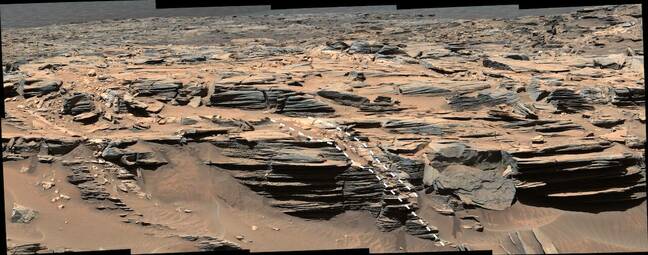This article is more than 1 year old
The balmy equator of Mars looks rich in opal-bound water
The poles have ice but it's freezing up there, so why not grind gems for cocktails?
A study of old data from the Curiosity rover is causing scientists to reassess their belief that Mars' relatively temperate equatorial region is devoid of water.
While water might not exist in a liquid form on the surface anymore, a study found evidence of a high concentration of opal just below Mars' surface that is surprisingly water-rich and could be a resource for future manned missions.
The study, led by US government research physicist Travis Gabriel, started with a look at some old images from Curiosity, which landed on Mars in 2012. Since then, the rover has been on a journey through the Gale Crater toward Mount Sharp, a towering three-mile (5km) mound at the center of the 96-mile wide impact site.
The images that sparked the opal discovery research showed a number of fractures on the Martian surface in Gale Crater, some of which stretched into the horizon. Those fractures all sport a "fracture halo" of lighter-colored stones.
Curiosity was able to deduce the possible existence of opal in some of those more recent scans using its laser-induced breakdown spectrometer, ChemCam. Gabriel participated in that research, which prompted this latest discovery.
Once Gabriel and his team realized there was water in the opal found in recent experiments, they decided to go back and look at archival data gathered from Curiosity's Dynamic Albedo of Neutrons, or DAN spectrometer. Using a newly developed analytical method, the team independently verified the presence of opal in the halos at other fractures, meaning there could be a lot of water-rich mineraloids around the Martian equator.
"Our new analysis of archival data showed striking similarity between all of the fracture halos we've observed much later in the mission … Seeing that these fracture networks were so widespread and likely chock-full of opal was incredible," Gabriel said.
Life on Mars?
Opals are a mineraloid (meaning non-crystalline mineral-like substance) that primarily consist of silica and water. "On Earth, silica falls out of solution in places like lake and ocean bottoms and can form in hot springs and geysers," Arizona State University said.
Opals tend to become more crystalline and often lose some of their water content as they age (which averages somewhere between 6 and 10 percent), but Gabriel and his team believe the ones they've found on Mars are still water rich.
Given its water richness, scientists believe the opal in Gale Crater formed in one of Mars' more modern eras when surface water may have been mostly gone and Mars already hostile to life.
"Given the widespread fracture networks discovered in Gale Crater, it's reasonable to expect that these potentially habitable subsurface conditions extended to many other regions of Gale Crater as well, and perhaps in other regions of Mars," Gabriel said.
Rocks go in, water comes out
Microbial life is great, but we can look for that once we get there - right now we have to find out how to survive on the Red Planet.
It wasn't long ago that scientists discovered the presence of frozen water at Mars' polar regions, spurring many to say that if humans explore Mars we may be confined to those even-less-friendly regions of Mars, which is pretty inhospitable to begin with.
But by grinding an opal into dust and adding heat, Curiosity scientists believe water can be extracted. If Mars' equator is as opal-rich as Gabriel's data suggests, we might be able to take in Mars' balmy summer equatorial weather, where it can get as hot as 24°C (75°F) at midday, rather than being subjected to -153°C (-225°F) polar extremes.
One would imagine both astronauts and equipment being thankful for the change of scenery.
- China's Mars rover hibernates for a scarily long time
- Perseverance rover drops off first sample tube on surface of Mars
- NASA retires Mars InSight mission after it enters 'dead bus' condition
- Boffins hear Martian dust devils' rumbles for first time
Opal has been seen elsewhere on Mars' surface, but it's unknown if deposits outside of Gale Crater are as water-rich as those that Curiosity has scanned.
If they are as water abundant as those measured by Gabriel and his team, there's a lot of liquid to be extracted. In a pair of dedicated neutron experiments, the team found that a single meter of fracture halo could contain roughly a gallon and a half of water, and that's in just the first top foot of soil.
Gabriel and his team are still working with Curiosity and are investigating the role of water in the formation of Martian rocks, as the rover makes its way up the side of Mount Sharp. Unfortunately, the fracture halos appear to have dried up as the rover has climbed, the team said. ®

